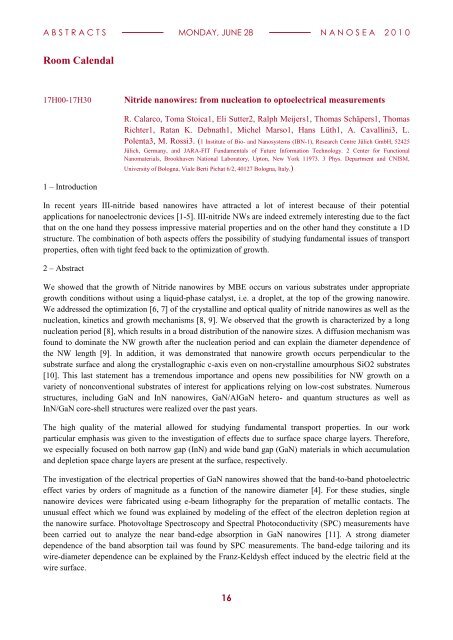book of abstracts - IM2NP
book of abstracts - IM2NP
book of abstracts - IM2NP
You also want an ePaper? Increase the reach of your titles
YUMPU automatically turns print PDFs into web optimized ePapers that Google loves.
A B S T R A C T S MONDAY, JUNE 28 N A N O S E A 2 0 1 0<br />
Room Calendal<br />
17H00-17H30<br />
Nitride nanowires: from nucleation to optoelectrical measurements<br />
R. Calarco, Toma Stoica1, Eli Sutter2, Ralph Meijers1, Thomas Schäpers1, Thomas<br />
Richter1, Ratan K. Debnath1, Michel Marso1, Hans Lüth1, A. Cavallini3, L.<br />
Polenta3, M. Rossi3. (1 Institute <strong>of</strong> Bio- and Nanosystems (IBN-1), Research Centre Jülich GmbH, 52425<br />
Jülich, Germany, and JARA-FIT Fundamentals <strong>of</strong> Future Information Technology. 2 Center for Functional<br />
Nanomaterials, Brookhaven National Laboratory, Upton, New York 11973. 3 Phys. Department and CNISM,<br />
University <strong>of</strong> Bologna, Viale Berti Pichat 6/2, 40127 Bologna, Italy.)<br />
1 – Introduction<br />
In recent years III-nitride based nanowires have attracted a lot <strong>of</strong> interest because <strong>of</strong> their potential<br />
applications for nanoelectronic devices [1-5]. III-nitride NWs are indeed extremely interesting due to the fact<br />
that on the one hand they possess impressive material properties and on the other hand they constitute a 1D<br />
structure. The combination <strong>of</strong> both aspects <strong>of</strong>fers the possibility <strong>of</strong> studying fundamental issues <strong>of</strong> transport<br />
properties, <strong>of</strong>ten with tight feed back to the optimization <strong>of</strong> growth.<br />
2 – Abstract<br />
We showed that the growth <strong>of</strong> Nitride nanowires by MBE occurs on various substrates under appropriate<br />
growth conditions without using a liquid-phase catalyst, i.e. a droplet, at the top <strong>of</strong> the growing nanowire.<br />
We addressed the optimization [6, 7] <strong>of</strong> the crystalline and optical quality <strong>of</strong> nitride nanowires as well as the<br />
nucleation, kinetics and growth mechanisms [8, 9]. We observed that the growth is characterized by a long<br />
nucleation period [8], which results in a broad distribution <strong>of</strong> the nanowire sizes. A diffusion mechanism was<br />
found to dominate the NW growth after the nucleation period and can explain the diameter dependence <strong>of</strong><br />
the NW length [9]. In addition, it was demonstrated that nanowire growth occurs perpendicular to the<br />
substrate surface and along the crystallographic c-axis even on non-crystalline amourphous SiO2 substrates<br />
[10]. This last statement has a tremendous importance and opens new possibilities for NW growth on a<br />
variety <strong>of</strong> nonconventional substrates <strong>of</strong> interest for applications relying on low-cost substrates. Numerous<br />
structures, including GaN and InN nanowires, GaN/AlGaN hetero- and quantum structures as well as<br />
InN/GaN core-shell structures were realized over the past years.<br />
The high quality <strong>of</strong> the material allowed for studying fundamental transport properties. In our work<br />
particular emphasis was given to the investigation <strong>of</strong> effects due to surface space charge layers. Therefore,<br />
we especially focused on both narrow gap (InN) and wide band gap (GaN) materials in which accumulation<br />
and depletion space charge layers are present at the surface, respectively.<br />
The investigation <strong>of</strong> the electrical properties <strong>of</strong> GaN nanowires showed that the band-to-band photoelectric<br />
effect varies by orders <strong>of</strong> magnitude as a function <strong>of</strong> the nanowire diameter [4]. For these studies, single<br />
nanowire devices were fabricated using e-beam lithography for the preparation <strong>of</strong> metallic contacts. The<br />
unusual effect which we found was explained by modeling <strong>of</strong> the effect <strong>of</strong> the electron depletion region at<br />
the nanowire surface. Photovoltage Spectroscopy and Spectral Photoconductivity (SPC) measurements have<br />
been carried out to analyze the near band-edge absorption in GaN nanowires [11]. A strong diameter<br />
dependence <strong>of</strong> the band absorption tail was found by SPC measurements. The band-edge tailoring and its<br />
wire-diameter dependence can be explained by the Franz-Keldysh effect induced by the electric field at the<br />
wire surface.<br />
16

















